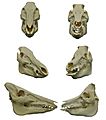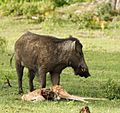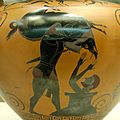Wild boar facts for kids
Quick facts for kids Wild Boar |
|
|---|---|
 |
|
| Conservation status | |
| Scientific classification | |
| Kingdom: | |
| Phylum: | |
| Class: | |
| Order: | |
| Family: | |
| Genus: |
Sus
|
| Species: |
S. scrofa
|
| Binomial name | |
| Sus scrofa |
|
The wild boar (Sus scrofa) is a type of pig that belongs to the family called Suidae. These amazing animals live in many parts of the world today. You can find them in their natural habitats and also in many countries where they were introduced by humans.
Wild boars are omnivores, meaning they eat both plants and animals. They are also very good at adapting to new places and changes in their environment. For a long time, people in Europe hunted wild boars for different parts of their bodies. These animals were also important in the mythology of many old civilizations. For example, in Greek, Phoenician, and Persian stories, wild boars were sometimes seen as fierce or even evil. But in other stories, they were brave and powerful. Some people even thought they were like parasites. Even today, people have very different ideas about wild boars!
Did you know that wild boar hair was used to make toothbrushes until the 1930s? The hair for the bristles usually came from the boar's neck. These brushes were popular because the bristles felt soft. However, they weren't the best for keeping teeth clean. This is because the hairs dried slowly and could hold bacteria.
Contents
How to Spot a Wild Boar
Wild boars have a very unique look. When you see a wild boar from the side, it often looks very large and strong. This is partly because their legs are quite short compared to their big bodies. Their legs might not look super strong, but they are!
Wild Boar Body Features
A wild boar's head is very big. Its eyes are set high up on its head, and its ears are small with stiff hairs around them. The wild boar's tail can move very quickly. They often use their tail to show how they are feeling. If you see a wild boar from the front, its body looks quite narrow. Wild boars have 44 teeth in their jaw, which helps them have a very strong bite. Male and female wild boars even have slightly different snout shapes!
Wild Boar Life Cycle

Wild boars usually give birth to about 4 to 6 babies at a time. These baby boars are called piglets. When they are first born, piglets weigh about 750 to 1000 grams.
Baby Boars: Piglets
Piglets start eating solid foods like worms and grubs after about two weeks. They are fully weaned (meaning they stop drinking their mother's milk) after 3 to 4 months. They grow up quickly!
More Wild Boar Pictures
-
Wild boar (left) and domestic pig (right) skulls. Notice how the domestic pig's face is much shorter!
-
A male Indian boar eating a chital (deer) that has died.
-
A Banded pig being eaten by Komodo dragons.
-
A group of wild boars and domestic pigs together at Culzie, Scotland.
-
Wild "Razorbacks" facing an American alligator in Florida.
-
An ancient Upper Paleolithic cave painting from Altamira, Spain. This is one of the oldest pictures of a wild boar!
-
Herakles bringing the Erymanthian boar to Eurystheus, shown on an old Greek pot (around 550 BC).
-
An old Roman carving showing a dog facing a boar, from Cologne.
-
People hunting boars with spears in British India.
-
A boar that was shot in Volgograd Oblast, Russia.
-
The Boar Hunt – a painting by Hans Wertinger, around 1530, from the Danube Valley.
See also
 In Spanish: Jabalí para niños
In Spanish: Jabalí para niños






















